
Ephedra distachya is a shrub in the family Ephedraceae that stands about 25 cm to 50 cm high. The shrub grows in many parts of the world, including southern and central Europe and western and central Asia. Its local names include somlatha.

Ephedra is a genus of gymnosperm shrubs. The various species of Ephedra are widespread in many arid regions of the world, ranging across southwestern North America, southern Europe, northern Africa, southwest and central Asia, northern China and western South America. It is the only extant genus in its family, Ephedraceae, and order, Ephedrales, and one of the three living members of the division Gnetophyta alongside Gnetum and Welwitschia.

Ephedra aspera is a species of Ephedra known by the common names rough jointfir, boundary ephedra, and pitamoreal. It is native to the southwestern United States from California to Texas and parts of northern Mexico as far south as Zacatecas. It is a resident of varied woodland and scrub plant communities.

Ephedra californica is a species of Ephedra, known by the common names California jointfir, California ephedra, desert tea, Mormon tea, and cañatillo.
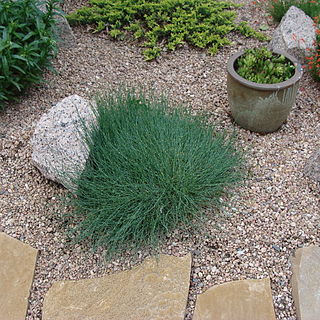
Ephedra funerea is a species of Ephedra, known by the common name Death Valley jointfir, Death Valley ephedra, or Mormon Tea.
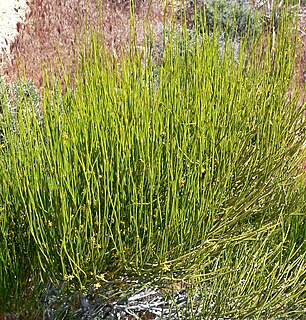
Ephedra viridis, known by the common names green Mormon tea, green ephedra, and Indian tea, is a species of Ephedra. It is indigenous to the Western United States, where it is a member of varied scrub, woodland, desert, and open habitats. It grows at 900–2,300 metres (3,000–7,500 ft) elevations.

Lycium andersonii is a species of flowering plant in the nightshade family, Solanaceae. Its common names include water-jacket, redberry desert-thorn, Anderson thornbush, Anderson's desert thorn, Anderson boxthorn, Anderson lycium, Anderson wolfberry, and squawberry.

Eschscholzia glyptosperma is a species of poppy known by the common names desert gold poppy, desert golden poppy, and Mojave poppy.

Hibiscus lasiocarpos is a species of hibiscus known by the common name hairy-fruited hibiscus. It is also one of several hibiscus called rosemallow. It is native to much of the southeastern United States, as well as parts of California and northern Mexico. It is a large, bushy perennial herb with sprawling stems reaching one to two meters long. The leaves are heart-shaped, toothed, and pointed, and generally between 6 and 10 centimeters long. The inflorescence holds large showy, solitary flowers. Each flower has a cup of partly fused sepals beneath a layer of slender bracts. These may be covered in hairs or woolly fibers. The flower's large petals may be up to 10 centimeters long and are generally bright white with red bases. The stamen tube and anthers are white or cream. The fruit is a capsule 2.5–3 centimeters long containing spherical seeds.
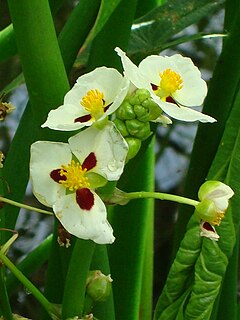
Sagittaria montevidensis is a species of flowering plant in the water-plantain family Alismataceae. Common names include giant arrowhead and California arrowhead.
Ephedra alata is a species of Ephedra. These plants are perennial and xerophytic gymnosperm shrubs.

Ephedra nevadensis, commonly known as Nevada ephedra, gray ephedra, Mormon tea and Nevada jointfir, is a species of gymnosperm native to dry areas of western North America.

Astragalus nuttallianus is a species of milkvetch known by the common names smallflower milkvetch and turkeypeas. It is native to the southwestern and south central United States and northern Mexico, where it can be found in many types of habitat, often in dry areas.
Myosurus cupulatus is a species of flowering plant in the buttercup family known by the common name Arizona mousetail. It is native to the southwestern United States and northern Mexico, where it grows in moist and dry habitat types in desert, scrub, and woodland. It is an annual plant forming a small tuft up to about 14 centimeters tall. The leaves are linear to lance-shaped and up to 7 centimeters in length. The inflorescence produces a single flower which has an elongated, cylindrical or cone-shaped receptacle up to 4 centimeters long. At the base of the receptacle are curving, spurred sepals and five petals each under 3 millimeters long.

Orobanche cooperi is a species of broomrape known by the common name Cooper's broomrapedesert broomrape, spike broomrape, and burroweed strangler. It is native to the desert regions of the southwestern United States and northern Mexico, where it is a parasite growing attached to the roots of other plants, usually members of the Asteraceae, such as Artemisia, Hymenoclea, Ambrosia and Encelia. Although not usually weedy, it has been found infesting agricultural cropland, including tomato fields in inland California. This plant arises from a thick root and a scaly, twisted stem base, and produces a thick, clumpy stem up to 40 centimeters tall. As a parasite taking its nutrients from a host plant, it lacks leaves and chlorophyll. It is dark purple in color and coated with glandular hairs. The inflorescence is an elongated array of several flowers. Each flower is tubular, purple and hairy, and up to about 3 centimeters long.

Rosa woodsii is a species of wild rose known by the common names Woods' rose, interior rose, common wild rose, mountain rose, pearhip rose, and prairie rose.
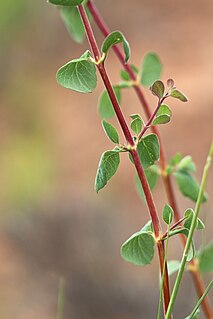
Symphoricarpos longiflorus is a species of flowering plant in the honeysuckle family known by the common names desert snowberry and fragrant snowberry. It is native to the western United States from the Great Basin to western Texas, as well as northwestern Mexico.

Tetracoccus hallii is a species of flowering shrub in the family Picrodendraceae, known by the common names Hall's shrubby-spurge and Hall's tetracoccus.
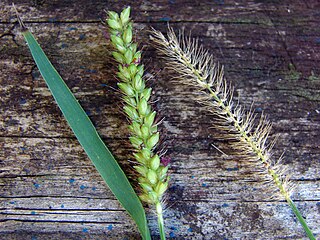
Setaria parviflora is a species of grass known by the common names marsh bristlegrass, knotroot bristle-grass, bristly foxtail and yellow bristlegrass. It is native to North America, including Mexico and the United States from California to the East Coast, Central America and the West Indies, and South America.
Ephedra pedunculata, common name Clap-weed, vine Mormon tea or Comida de Vívora, is a plant species native to southern Texas and to Mexico as far south as Zacatecas. It grows in sandy or rocky slopes and outcrops.

















